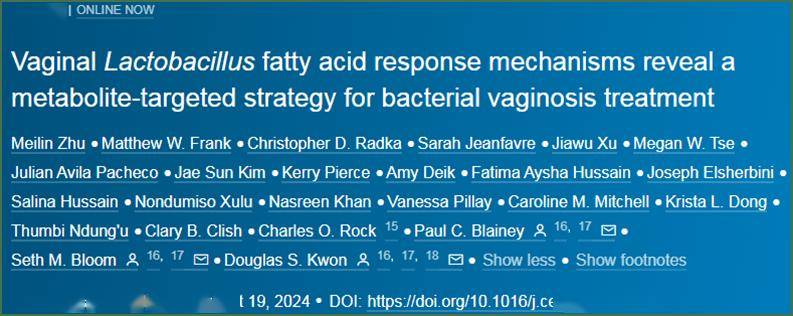Source: Biological Valley
More than half of women worldwide will experience bacterial vaginosis (BV) at least once in their lifetime, a common disease caused by an imbalance of natural microbes in the reproductive tract. BV can cause discomfort such as pain and abnormal discharge, and although it can be treated with antibiotics, it often recurs. Left untreated, BV can lead to complications during pregnancy and increase the risk of sexually transmitted infections (including HIV).
In a new study, researchers from the Broad Institute, Ragon Institute, and St. Jude Children’s Research Hospital found that oleic acid – one of the most abundant fatty acids in the human body – can restore the healthy balance of vaginal microbiota in a bacterial vaginosis laboratory model.
The study results were published online in the journal Cell on August 19, 2024, with the title “Vaginal Lactobacillus fatty acid response mechanisms reveal a metabolite-targeted strategy for bacterial vaginosis treatment.”
The results show that oleic acid and several other unsaturated long-chain fatty acids not only constitute an important part of the cell membrane but also possess antibacterial properties that can inhibit the growth of vaginal microbes associated with adverse health outcomes, while promoting the growth of other microbial species related to a healthy female reproductive tract. This therapeutic approach that promotes microbial balance may help prevent recurrent vaginal infections in the future.
The first author of the paper stated, “Existing treatments are like flipping a coin, a situation that has not changed in over 40 years of medical practice, so we need new ways to help patients.”
The Magic of Oleic Acid
The human female reproductive tract is usually colonized by microbes from the Lactobacillus genus. Antibiotic treatment of BV can disrupt the balance of lactobacilli, leading to an increase in Lactobacillus iners, a bacterium that makes BV more likely to recur.
In this study, researchers aimed to find ways to promote the growth of Lactobacillus crispatus, which can create a more stable microbial environment than Lactobacillus iners. They planned to study the effect of different compounds on the growth of Lactobacillus crispatus using a high-throughput screening technique developed by the Blainey Lab. However, before the screening began, researchers found a crucial clue: an ingredient in the culture medium used to culture lactobacilli was disrupting the screening method, and without this ingredient, lactobacilli could not grow in the medium.
During troubleshooting, researchers found that many lactobacilli require oleic acid, a component in the culture medium, to grow. When they cultured different strains of lactobacilli with oleic acid, they found that oleic acid inhibited the growth of Lactobacillus iners and promoted the growth of lactobacilli strains associated with a healthy microbiota, such as Lactobacillus crispatus.
The research team used RNA sequencing technology and collaborated with the Broad Institute’s metabolomics platform and a team at St. Jude Children’s Research Hospital to identify a set of genes involved in processing unsaturated long-chain fatty acids, which are only present in non-Lactobacillus iners species. One of the genes encodes oleate hydratase, an enzyme that converts scarce resources of unsaturated long-chain fatty acids into a form only usable by bacteria possessing this enzyme. Another gene encodes a fatty acid efflux pump, which is necessary for bacteria to respond to high concentrations of oleic acid.
Image source: Cell, 2024, doi:10.1016/j.cell.2024.07.029
The first author of the paper, Zhu, said, “We used state-of-the-art genetic tools, which are the ‘gold standard’ for any mechanism study, but many researchers in the field of vaginal microbiology have not had the opportunity to use them. This is a significant step forward in this field.” She added that the field of vaginal microbiology has not received equal resources compared to other microbiology fields.
The research team also simulated how oleic acid affects the vaginal microbiota of BV patients by co-culturing bacteria associated with BV, Lactobacillus iners, and Lactobacillus crispatus. Oleic acid effectively inhibited the growth of Lactobacillus iners and most BV-related bacteria, including some strains resistant to antibiotic treatment. This suggests that oleic acid may be an effective means of restoring a stable, healthy microbiota in the female reproductive tract.
The co-corresponding author of the paper, Seth Bloom, said, “This study demonstrates that understanding the core metabolic needs and functions of key bacteria can directly guide the emergence of new therapies, allowing us to adjust the microbiota to improve health outcomes.”
At the Ragon Institute, the Kwon Lab is working to advance this research to human clinical trials. Kwon stated, “We believe that translating these research findings into methods that can durably alter the vaginal microbiota to improve BV treatment and reduce the adverse health outcomes faced by women globally holds exciting potential.”
Reference:
Meilin Zhu et al. Vaginal Lactobacillus fatty acid response mechanisms reveal a metabolite-targeted strategy for bacterial vaginosis treatment. Cell, 2024, doi:10.1016/j.cell.2024.07.029.
(Source: Biological Valley)


